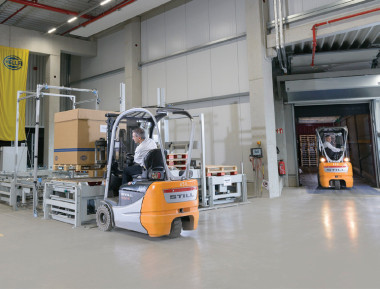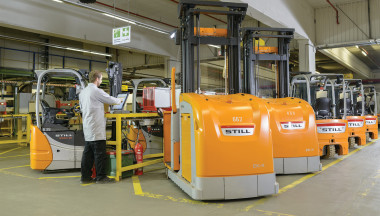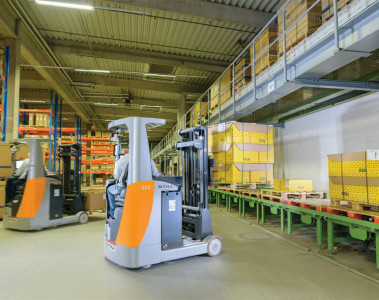Hella
Improved forklift capacity, reduced fleet size.
Challenge: Better utilisation of the entire fleet and capital expenditure for reducing maintenance and operations.
Solution: Harmonisation of the fleet. Reduction in the number of trucks by 20 percent. Global, web-based fleet management. Active truck allocation, determined based on availability, type of use and utilisation.
STILL products: FleetManager 4.x withOptiTruck function.

No other technological development will have as much of a dramatic effect on company management in the coming years as machine networking. An example of this is the new OptiTruck hardware and software package for fleet management developed by the intralogistics specialist STILL. Thanks to the active distribution of a forklift and the continuous analysis of usage behaviour, the industrial truck fleet is being used to capacity a lot more effectively. In the Erwitte logistics centre, Hella has been able to reduce its fleet size by 20 percent and has considerably reduced its costs in terms of capital expenditure, maintenance and operations thanks to the OptiTruck.
Optimised logistics processes increase the delivery service level
“Our products need to go out into the world and that is where we come in”, states Head of the Intralogistics Competence Centre of Hella Distribution, Markus Brunnen. Hella. Improved forklift capacity, reduced fleet size. 1 — STILL I Hella The intragroup service provider runs the highly automated Hella joint warehouse in Erwitte. If an order is placed at around 18:00 in the evening, it is delivered at around 08:00 the next day: around 140 lorries leave the distribution centre every day. 160 industrial trucks are in operation in order to ensure a timely and smooth delivery process.
By optimising intralogistics processes, lead times are reduced and the delivery service level is increased. When the Intralogistics Competence Centre was founded, the main question was: “Is the forklift only a means to an end or should it be better integrated into the logistics process?” The OptiTruck fleet manager developed together with STILL as part of a pilot project is the answer to this question.
Standardised trucks, reduced maintenance costs
The central task of the Competence Centre is to organise the forklifts within the group. Markus Brunnen explains: “STILL has long been the leading provider of electric industrial trucks and is a competent partner for system solutions in intralogistics”. The industrial trucks provided by different manufacturers were initially standardised by STILL and the truck capacity was harmonised. With even distribution of the load, the running time of the industrial trucks is significantly longer than five years. Consequently, the acquisition costs for the lucrative leasing of the trucks pay off within the group.
As lead buyer, Hella is responsible for acquisitions within the European branches. As a result of globalisation, processes will be translocated to other European countries at Hella as well. Thanks to the high compatibility of the fleet of forklifts, industrial trucks can be exchanged for consistent utilisation, even on different sites in Europe. The resulting process optimisation in spare parts management leads to a reduction in maintenance and operating costs - even within the European business.
Harmonisation of the fleet, reduction of the fleet size
The web-based FleetManager 4.x by STILL guarantees fleet management on different sites throughout the world. By actively assigning trucks with the OptiTruck function, the fleet of forklifts is better used to capacity. The fleet manager determines which truck will be assigned to the driver for the upcoming task. At the same time, other drivers are blocked from using this truck. As a result of precise timing in order assignment, commissioning and returns, OptiTruck by STILL offers complete transparency with regard to the availability and duration of use of individual trucks and therefore the potential for further optimisations and cost-savings.
You will find the central station for handing over and returning the equipment at the heart of the new FleetManager function. Employees can place their driving licence on the card reader located on the touch-pad terminal, see the tasks to be completed and then make a selection. The system calculates the best truck for the activity, based on operating hours and the age of the truck.
Moreover, the driver can report damage to the truck, with this information immediately being passed on to the Hella workshop by email. The truck must then not be used until it has been repaired. As a result of the transparent availability and duration of use of the fleet of trucks, better fleet management is achieved. What is more, the uniform utilisation of the fleet and maximisation of the operating times ultimately lead to a reduction in the fleet size.
Rapid repairs, increase in availability
When gaining access via OptiTruck, every driver is also identified. Any faults or damage to the truck are reported immediately when returning it to the terminal. A faulty forklift is blocked until it has been repaired and the Hella workshop in Erwitte is informed of this immediately by email. In this way, the fleet manager is for the first time able to determine the exact availability of each fleet truck. In addition to shock detection via sensors on the truck, the OptiTruck by STILL also offers an additional option for recording damage to a truck.
“Thanks to the certified workshop partnership, we are on equal terms with every STILL workshop and have access to the equipment technology. Due to the very short reaction times in our workshop, we are able to repair a faulty truck more quickly and put it back into operation immediately. Due to the increase in availability, the separate maintenance concept plays an important role in managing internal group leasing“, emphasises Markus Brunnen.
Analysis of the report, uniform truck utilisation
The extensive reports in OptiTruck offer a need-oriented analysis and easily ascertainable assessment of all available truck data. All information regarding the time of referral, return and damages is recorded in the activity report, resulting in a full biography of the fleet truck in terms of its use. Thanks to constant analyses of the chart, the actual operating times, types of use and operating hours are determined and assessed with full transparency for each industrial truck. Trucks of the same design and age can be conveniently summarised for assessment. The discrepancy between the draft and the actual operating time can be easily determined at the push of a button. Downtime and maintenance times can also be called up with the availability reports and can be better controlled together with the UVV test deadlines.
Decisions are made based on information
Whether energy consumption, lifespan of batteries or information regarding the suitability of specific truck types for specific usages, the STILL fleet manager always supplies valuable information and analyses regarding the processes for the entire intralogistics supply chain. When optimising, planning and designing warehouses with high shelving and wide aisles or material handling, the analyses carried out by the fleet manager often form the basis for the decision-making processes.
Autonomous fleet management
Cyber-physical fleets consist of trucks that are connected to one another, which are controlled by means of a continuous exchange of data, for example via the internet. The autonomous fleet manager transfers server know-how to the trucks that are intelligently connected to one another.
Summary
Thanks to the OptiTruck function of STILL FleetManager 4.x, the fleet of forklifts is better utilised in the Hella joint warehouse in Erwitte. The fleet size consisting of 160 trucks was reduced by 20 percent within two years with the same stock turnover. In addition to capital expenditure, maintenance and operating costs were also significantly reduced. “Based on precise timekeeping in order assignment, commissioning and returns, the exact duration of use of the fleet of trucks is first recorded: approach for further optimisations. The OptiTruck function is therefore a ‘tool’ for continuously optimising the process for the entire fleet of forklifts”, explains the Head of the Intralogistics Competence Centre with satisfaction. The deployment of a total of ten tugger trains is planned, which will primarily be used in the recently-developed production hall. Front loaders will then only continue to be used for loading and unloading lorries.




